

'Dilithium crystals' could cut Mars travel time to three months. Humanity has been in space for a while, but we really haven't managed to go very far.
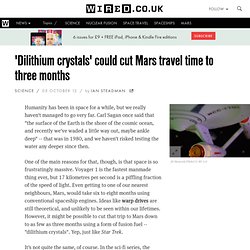
Carl Sagan once said that "the surface of the Earth is the shore of the cosmic ocean, and recently we've waded a little way out, maybe ankle deep" -- that was in 1980, and we haven't risked testing the water any deeper since then. One of the main reasons for that, though, is that space is so frustratingly massive. Voyager 1 is the fastest manmade thing ever, but 17 kilometres per second is a piffling fraction of the speed of light. Even getting to one of our nearest neighbours, Mars, would take six to eight months using conventional spaceship engines. Ideas like warp drives are still theoretical, and unlikely to be seen within our lifetimes. It's not quite the same, of course. Untitled. Star Trek fans take note: Have a seat before you read the next sentence or prepare to swoon.

University of Alabama-Huntsville (UAH) aerospace engineers working with NASA, Boeing and Oak Ridge National Laboratory are investigating how to build fusion impulse rocket engines for extremely high-speed space travel. “Star Trek fans love it, especially when we call the concept an impulse drive, which is what it is,” says team member Ross Cortez, an aerospace engineering Ph.D. candidate at UAH’s Aerophysics Research Center. Stay seated Trekkies, because there’s more. “The fusion fuel we’re focusing on is deuterium [a stable isotope of hydrogen] and Li6 [a stable isotope of the metal lithium] in a crystal structure. That’s basically dilithium crystals we’re using,” Cortez says, referring to the real-world equivalent of the fictional element used to power Star Trek’s Starship Enterprise. Major problems to solve There’s a big gap between hopes and goals, though. Z-pinch fusion and magnetic nozzles. Newest Fusion Engine Is Powered On Star Trek Like Dilithium Crystals.
Brace yourselves: Researchers at University of Huntsville in Alabama say they are using "Dilithium Crystals" in a new fusion impulse engine that could Txchnologist, an online magazine sponsored by General Electric, talked to team member and aerospace engineering PH.D. candidate Ross Cortez, he said "The fusion fuel we're focusing on is deuterium [a stable isotope of hydrogen] and Li6 [a stable isotope of the metal lithium] in a crystal structure.

" "That's basically dilithium crystals we're using," he said. Trekkies everywhere shudder in delight. The researchers say that this type of engine is what NASA needs to propel human beings outside low-Earth orbit, out to places like Mars and even beyond. Not so fast though, the military will probably get first dibs. The whole projects is only possible from repurposing military nuclear testing equipment, essentially stuff America used to test nuclear weapons.
Untsville - News - Research News. HUNTSVILLE, Ala. – Can a device formerly used to test nuclear weapons effects find a new life in rocket propulsion research?
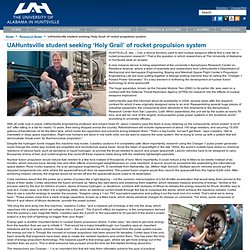
That is the question in which researchers at The University of Alabama in Huntsville seek an answer. A new massive device is being assembled at the university’s Aerophysics Research Center on Redstone Arsenal, where a team of scientists and researchers from UAHuntsville’s Department of Mechanical and Aerospace Engineering, Boeing and Marshall Space Flight Center’s Propulsion Engineering Lab are busy putting together a strange looking machine they’re calling the “Charger-1 Pulsed Power Generator.” 'Star Trek' fusion impulse engine in the works. There's a hierarchy of "Star Trek" inventions we would like to see become reality.
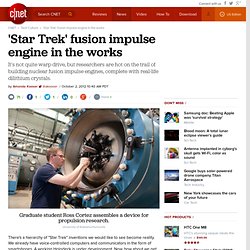
We already have voice-controlled computers and communicators in the form of smartphones. How Fusion Propulsion Will Work" Fusion reactions release an enormous amount of energy, which is why researchers are devising ways to harness that energy into a propulsion system.
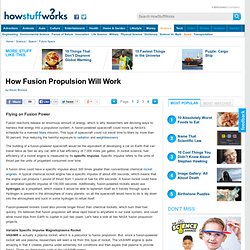
A fusion-powered spacecraft could move up NASA's schedule for a manned Mars mission. This type of spacecraft could cut travel time to Mars by more than 50 percent, thus reducing the harmful exposure to radiation and weightlessness. Nuclear pulse propulsion. Project Orion[edit] A nuclear pulse propulsion unit, the explosive charge ablatively vaporizes the propellant, propelling it away from the charge, and simultaneously creating a plasma out of the propellant, the propellant then goes on to impact the pusher plate at the bottom of the Orion spacecraft, imparting a pulse of 'pushing' energy.

Project Orion was the first serious attempt to design a nuclear pulse rocket. The design effort was carried out at General Atomics in the late 1950s and early 1960s. The idea of Orion was to react small directional nuclear explosives against a large steel pusher plate attached to the spacecraft with shock absorbers. Efficient directional explosives maximized the momentum transfer, leading to specific impulses in the range of 6,000 seconds, or about thirteen times that of the Space Shuttle Main Engine. Impulse drive. In the fictional Star Trek universe, the impulse drive is the method of propulsion that starships and other spacecraft use when they are travelling below the speed of light.[1] Typically powered by deuterium fusion reactors, impulse engines let ships travel interplanetary distances readily.
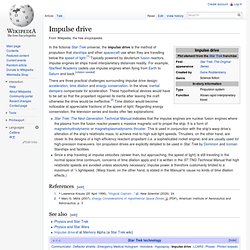
For example, Starfleet Academy cadets use impulse engines when flying from Earth to Saturn and back. [citation needed] There are three practical challenges surrounding impulse drive design: acceleration, time dilation and energy conservation. In the show, inertial dampers compensate for acceleration. Untsville Aerophysics Research Center. Ray Vaughn, PhD Vice President for Research Welcome to the UAH Office of Research!

We are very proud of our research record and our extremely productive faculty, research staff, and student body that have contributed to UAH being named by The Carnegie Foundation for the Advancement of Teaching to the "Very High Activity" research category, placing us among a select group of public universities in America with this ranking. Our research endeavors vary greatly according to discipline and research center interest.
Today, NASA and the Department of Defense remain our largest research sponsors. UAH consistently ranks among the top universities with respect to both NASA and DoD research expenditures as reported by the National Science Foundation. Researchers working on Star Trek-style fusion impulse engines. Hear that, Star Trek?

Technology is catching up! The University of Alabama's Aerophysics Research Center, NASA, Boeing, and Oak Ridge National Laboratory are all getting together to develop an "impulse engine" that's powered in part by "dilithium crystals. "